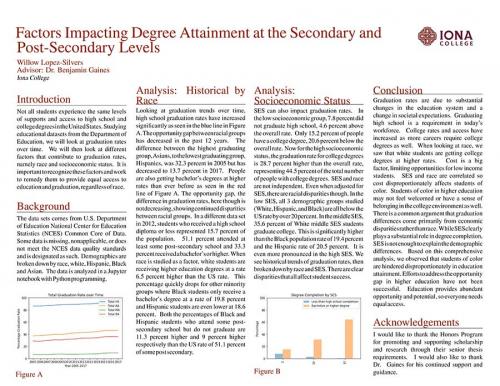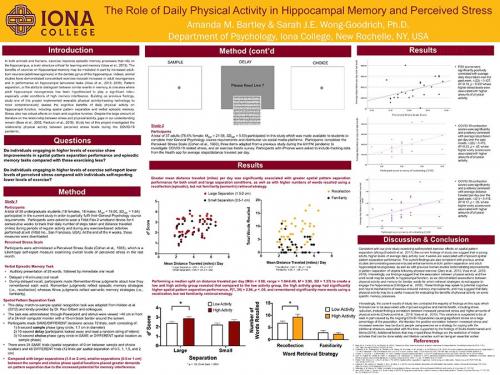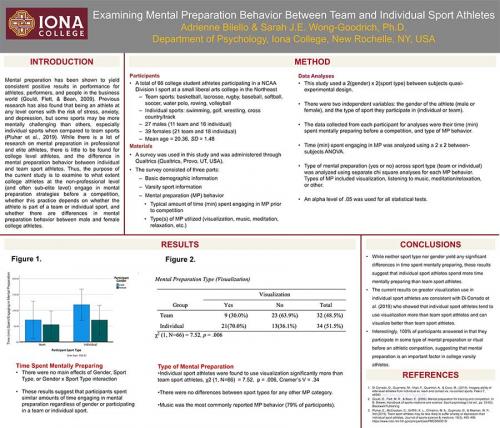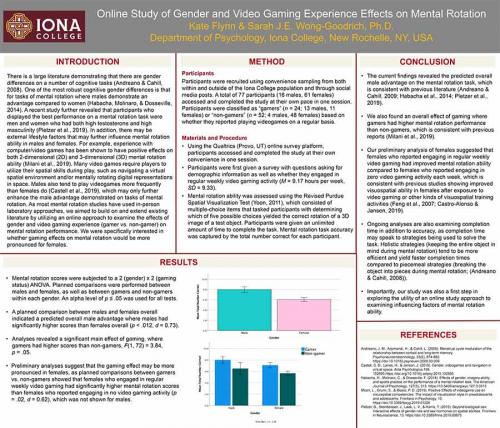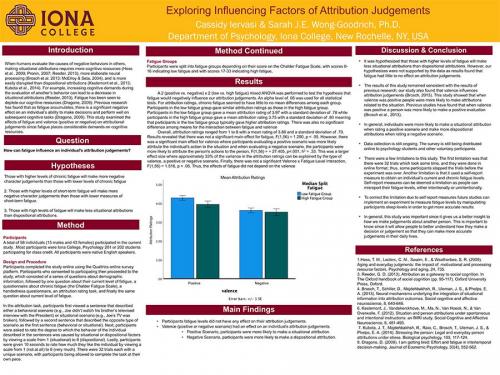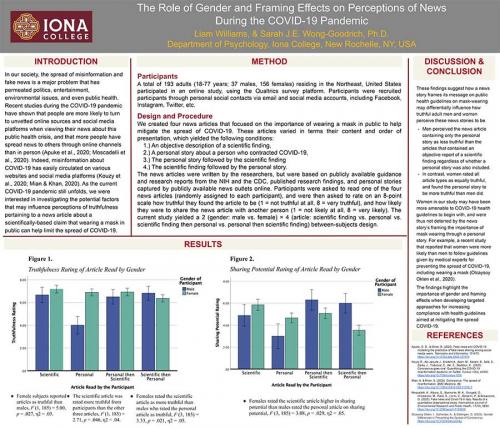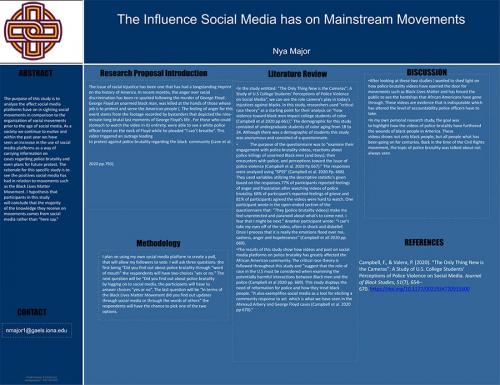ISD Poster Presentations: Social Science
Welcome to Iona Scholars Day 2021! Each poster presentation includes a link to participate in a live Zoom session where attendees will have the opportunity to meet the presenters, ask questions and discuss the project. These live, interactive sessions will occur on April 22 from 11 a.m. - noon and 1 - 2 p.m.
Willow Lopez-Silvers '21, Adolescent Education, Concentration in Mathematics
Faculty Advisor: Benjamin Gaines, Ph.D.

My poster is from my honors thesis, combining my interests of education, statistics, and demographic equity. I looked at different data sets from the Department of Education about high school and college graduation rates. I studied trends over time, the effects of race and socioeconomic status, and other factors. We see that low-income students and students of color are graduating at disproportionately lower rates through statistical testing and comparison.
Olivia Conte '21, Arts Leadership
Faculty Advisor: Hannah Park, Ph.D.

In this project, I will be examining effective marketing strategies needed for the successful running of a nonprofit arts organization based on my internship experience with ArtsWestchester, a nonprofit arts organization in Westchester County. This project will reveal the importance of branding, outreach, and creative integration of technology for effective marketing.
Live Presentation
Join us at 1 p.m. for a live Zoom session where participants will have the opportunity to learn more about this project.
1 p.m. session: Join from PC, Mac, Linux, iOS or Android
Password: 632758
Amanda Bartley '21, Psychology
Faculty Advisor: Sarah Wong-Goodrich, Ph.D.

The current project investigated the effects of physical activity on hippocampal memory and perceived chronic stress. Study 1 participants wore an activity tracker for 4 weeks, and then completed two memory tasks, a spatial pattern separation task and a free word recall task. These tasks are thought to be dependent on the hippocampus and the formation of new neurons in this brain region. Findings revealed that greater distance traveled was associated with higher spatial pattern separation performance and number of words recalled via recollection retrieval strategies. Study 2 participants completed the Perceived Stress Scale, a COVID-19 stress questionnaire, and an exercise habit survey. Surprisingly, findings revealed a positive correlation between perceived stress and exercise frequency. Typically, physical activity is associated with increased mental and physical health, including stress reduction. We hypothesize this unexpected result is due to the effects of the COVID-19 pandemic and stressors associated with it. The current findings highlight the varied effects of regular physical activity on cognitive and mood function.
Live Presentation
Join us at 11 a.m. for a live Zoom session where participants will have the opportunity to learn more about this project.
11 a.m. session: Join from PC, Mac, Linux, iOS or Android
Password: 628554
Adrienne Bilello '21, Psychology
Minor: Media and Strategic Communications
Faculty Advisor: Sarah Wong-Goodrich, Ph.D.

This study investigated any differences in mental preparation behavior based on sport (team or individual) and gender (male or female). The study focused on both the amount of time spent mentally preparing before a competition and the mental preparation technique that was used (visualization, listening to music, meditation etc.) All data was collected from surveys given to collegiate level athletes.
Live Presentation
Join us at 11 a.m. for a live Zoom session where participants will have the opportunity to learn more about this project.
11 a.m. session: Join from PC, Mac, Linux, iOS or Android
Password: 628554
Kate Flynn '21, Psychology
Faculty Advisor: Sarah Wong-Goodrich, Ph.D.

Abstract
Gender differences in mental rotation ability are well-established, but these gender differences may be further influenced by external factors. We examined the effects of video gaming and gender on a mental rotation task, using an online study approach. Analyses indicated a predicted overall male advantage on mental rotation task performance, supporting previous studies using in-person laboratory approaches. Preliminary analyses suggest a positive effect of weekly video gaming activity on mental rotation for females.
Summary
There is a large literature demonstrating that there are gender differences on a number of cognitive tasks (Andreano & Cahill, 2008). One of the most robust cognitive gender differences is that for tasks of mental rotation where males demonstrate an advantage compared to women (Habacha, Molinaro, & Dosseville, 2014). A recent study further revealed that participants who displayed the best performance on a mental rotation task were men and women who had both high testosterone and high masculinity (Pletzer et al., 2019). In addition, there may be external lifestyle factors that may further influence mental rotation ability in males and females. For example, experience with computer/video games has been shown to have positive effects on both 2-dimensional (2D) and 3-dimensional (3D) mental rotation ability (Milani et al., 2019). Many video games require players to utilize their spatial skills during play, such as navigating a virtual spatial environment and/or mentally rotating digital representations in space. Males also tend to play videogames more frequently than females do (Castell et al., 2019), which may only further enhance the male advantage demonstrated on tasks of mental rotation. As most mental rotation studies have used in-person laboratory approaches, we aimed to build on and extend existing literature by utilizing an online approach to examine the effects of gender and video gaming experience (gamer vs. non-gamer) on mental rotation. Based on previous literature, we predicted an overall male advantage on mental rotation accuracy. We also hypothesized that video gaming would have a positive effect on mental rotation accuracy for females, but that there would be no difference in mental rotation accuracy between male gamers and non-gamers.
Using the Qualtrics (Provo, UT) online survey platform, a total of 77 participants (16 males, 61 females) accessed and completed the study at their own convenience in one session. Participants were first given a survey with questions asking for demographic information as well as whether they engaged in regular weekly video gaming activity (M = 9.17 hours per week, SD = 9.33; ). Mental rotation ability was assessed using the Revised Purdue Spatial Visualization Test (Yoon, 2011), which consisted of multiple-choice items that tasked participants with determining which of five possible choices yielded the correct rotation of a 3D image of a test object. Participants were given an unlimited amount of time to complete the task. Mental rotation task accuracy was captured by the total number correct for each participant.
Per our hypothesis, we performed a planned comparison between males and females on mental rotation scores. As predicted, males performed significantly better than females overall, p < .012, Cohen’s d = 0.73. We also performed a 2 (gender: male vs. female) x 2 (gaming: gamer vs. non- gamer) ANOVA on mental rotation scores, but were likely underpowered to detect any significant effects given the small number of male participants that were recruited for this study. Based on our hypotheses, a preliminary analysis of females was performed and showed that females who engaged in regular weekly video gaming (n = 12) had significantly higher mental rotation scores than females who reported engaging in no video gaming activity (n = 49), p = .02, Cohen’s d = 0.62.
Using an online study approach, the current findings revealed the predicted overall male advantage on the mental rotation task, which is consistent with previous literature using in- person study administrations (Andreano & Cahill, 2009; Habacha et al., 2014; Hone et al., 2020; Jansen et al., 2019; Pletzer et al., 2019). Our preliminary analysis of females also suggested that females who reported engaging in regular weekly video gaming had improved mental rotation ability compared to females who reported engaging in zero video gaming activity each week, which is consistent with previous studies showing improved visuospatial ability, including mental rotation, in females after exposure to video gaming or other kinds of visuospatial training activities (Feng et al., 2007; Castro-Alonso & Jansen, 2019). Ongoing analyses are also examining completion time in addition to accuracy, as completion time may speak to strategies being used to solve the task. Holistic (keeping the entire object in mind during mental rotation) strategies tend to be more efficient and yield faster completion times compared to piecemeal (breaking the object into pieces during mental rotation) strategies. Importantly, our study was also a first step in exploring the utility of an online study approach to examining influencing factors of mental rotation ability.
Live Presentation
Join us at 1 p.m. for a live Zoom session where participants will have the opportunity to learn more about this project.
1 p.m. session: Join from PC, Mac, Linux, iOS or Android
Password: 632758
Cassidy Iervasi '21, Psychology
Minor: Neuroscience
Faculty Advisor: Sarah Wong-Goodrich, Ph.D.

When humans evaluate the causes of another’s behavior, they tend to focus more on dispositional factors, as situational attributions require more cognitive resources and more elaborate neural processing. This study examined the effects of fatigue and valence (positive or negative) on attributional judgements since fatigue places considerable demands on cognitive resources. The Chalder Fatigue Scale and an attribution rating task with 32 positive and negative scenarios were used to assess the effects of low and high fatigue on attribution ratings. Results suggested that fatigue had little to no effect on attribution judgements, but that positive scenarios yielded greater situational attributions.
Live Presentation
Join us at 11 a.m. for a live Zoom session where participants will have the opportunity to learn more about this project.
11 a.m. session: Join from PC, Mac, Linux, iOS or Android
Password: 628554
Liam Williams '21, Psychology
Faculty Advisor: Sarah Wong-Goodrich, Ph.D.

The spread of misinformation has been circulating for some time in our society. It can become very dangerous as people can be misled about information relating to their health or what is going on in the world. Considering the spread of news is especially prominent with the spread of COVID-19, our research focused on identifying potential factors that could influence one’s perception of misinformation in the news. Our research contained a total of 193 adults and we used a Qualtrics survey platform to administer our study. Each participant would read one article and report how truthful they found it to be and if they would share the article. However, the articles were entirely written by ourselves, but based on factual information from public health resources. The study used a two (gender; male vs. female) by four (one personal story about someone who had COVID-19, personal then scientific, and scientific then personal) between-subjects design. Participants were asked to rank how truthful they found the article to be (1 = not truthful at all, 8 = very truthful), and how likely they were to share the news article with another person (1 = not likely at all, 8 = very likely). In terms of results females ended up reporting articles as more truthful than males and rated the scientific article as more truthful than males who rated the personal article as truthful. Overall, the scientific article was rated as more truthful than the other articles. In terms of sharing potential, females ended up rating the scientific article as higher in sharing potential than males. The findings of gender differences showed the importance of how a news story frames a public message on health guidelines. We found that women may have been more open to suggestion and persuasion towards information about COVID-19. a recent study that reported that women were more likely than men to follow guidelines given by medical experts for preventing the spread of COVID-19, including wearing a mask (Olcaysoy Okten et al., 2020).
Live Presentation
Join us at 1 p.m. for a live Zoom session where participants will have the opportunity to learn more about this project.
1 p.m. session: Join from PC, Mac, Linux, iOS or Android
Password: 632758
Nya Major '21, Sociology
Faculty Advisor: Marcus Aldredge, Ph.D.

As we have learned the Civil Rights Movement was one that allowed for African Americans to protest against the racial injustices of the 1960's. Today, we see the same type of movements emerging such as the Black Lives Matter Movement. With this study, the intention is to understand the change of communicational mediums. The Civil Rights Movement was organized by church meetings however, the Black Lives Matter Movement used social media as a way of communicating with participants. This study will show how social media has allowed for a new way of communication.
Live Presentation
Join us at 11 a.m. for a live Zoom session where participants will have the opportunity to learn more about this project.
11 a.m. session: Join from PC, Mac, Linux, iOS or Android
Password: 628554
Christopher Delaney '21, Media & Strategic Communication
Faculty Advisor: Mitchell Bard, Ph.D.

For my Senior Seminar class, I had to write a research paper on a topic of my choice and, because of my enjoyment of film, I decided to write about diversity in movies. Both past and modern-day film were analyzed in order to understand how things have changed over the course of film history and what has changed in modern day film making.



